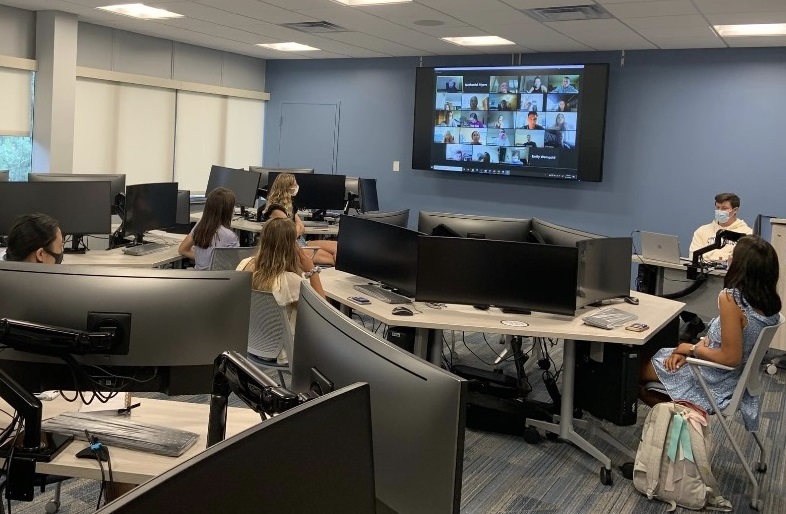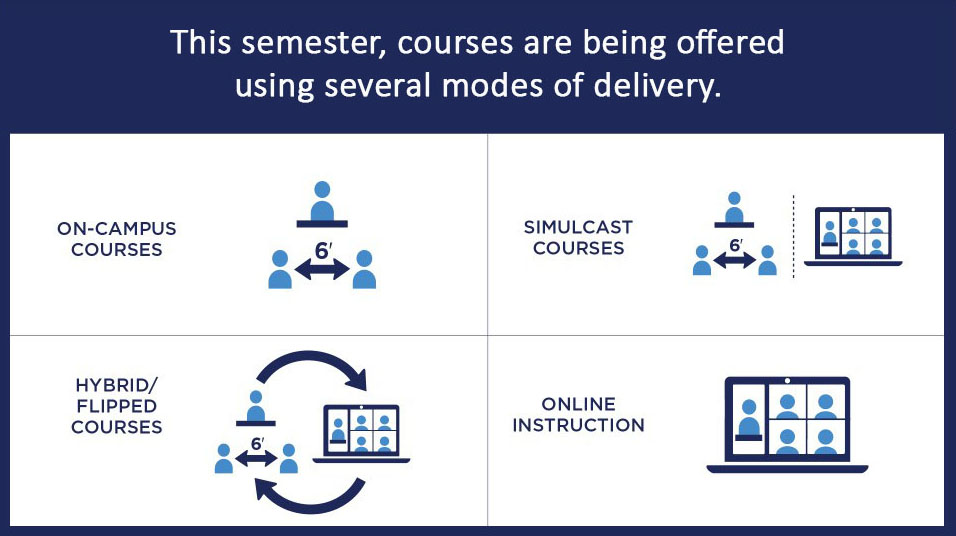Villanova Faculty Design Courses to Connect with Students Through Variety of Delivery Methods
Faculty have spent months hard at work, collaborating with partners across campus, to design and adapt courses to engage students through a variety of course dlivery methods this academic year, including in-person, hybrid, and various online formats.

Dr. Noelle Comolli, chair of the Department of Chemical and Biological Engineering, teaches a hybrid Computational Methods course (pictured here).
The start of classes for this academic year marked the beginning of Villanova University’s 178th year. Due to the continued impact of COVID-19—and the health and safety protocols in place—the student experience on campus and in the classroom is like no other year.
That said, extraordinary times call for extraordinary measures. Villanova faculty have been hard at work, designing courses for a variety of delivery methods. While the events of spring 2020 necessitated a quick shift to online delivery, all courses for this academic year were thoughtfully developed with a specific modality in mind.
Courses are being taught using several modes of delivery, including:
- On-campus, in-person courses in socially distanced classrooms;
- Simulcast courses, which include a combination of students participating in person in the classroom with a faculty member and via live stream from any location with an internet connection;
- Hybrid or flipped courses, which include a combination of in-person and online coursework. This can take varying forms but may include splitting students into two or three groups that alternate classroom attendance while the remaining content is delivered asynchronously via the online learning management system;
- Online instruction reflecting best practices in online course design, including synchronous and/or asynchronous interactive experiences.

Faculty use hybrid and online delivery methods for a variety of reasons. For many, it is a way to reimagine and deliver engaging course content. For others, it allows a level of student collaboration that isn’t possible in a socially distanced classroom. During the COVID-19 pandemic, these different modes of delivery also have additional benefits—aligning classroom demand with reduced classroom capacity, reducing student density in classroom buildings, and providing the flexibility to meet the needs of students and faculty with approved accommodations.
“Developing classes for hybrid and online delivery is different than in-person and nobody has embraced this change with more time and energy than our amazing faculty,” said University Provost Patrick G. Maggitti, PhD. “Though the semester will be different in many ways, students will learn from the same faculty experts who continue to bring their cutting-edge scholarship and teaching experience into the online classroom.”
Specialized teams across campus—including Villanova Institute for Teaching and Learning (VITAL), the Center for Instructional Technologies (UNIT CIT) and the University’s Online Programs Office—have been critical partners in helping Villanova’s faculty bring their visions to life.
Throughout the course of the 2020-21 academic year, we will be sharing stories on some of these innovative and engaging courses and the faculty behind them, the cross-campus collaborations that helped make them happen, and interesting ways in which students are using technology to learn and interact differently.
Innovative Courses:
- Online English Course Examines How Writing Allows Intimacies to Form Across Time and Distance
- Looking at the Pandemic Through a Legal Lens
- Coffee and True Crime: Murderino Course Connects America’s obsession with Murder and Justice with Gender and Performance
- Outdoor Biology lab is more than just “watching the grass grow” during a pandemic
- What The Troubles (and Derry Girls) are Teaching Students about 2020
- Business Students Continue to Receive Real-World Experience Outside of the Traditional Classroom
- Villanova Nursing Professor Uses Gaming Activities to Engage Students in Online Course
